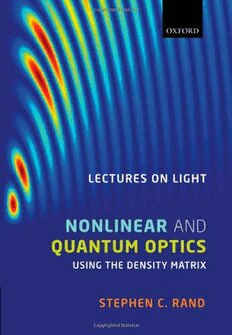Table Of ContentLectures on Light
This page intentionally left blank
Lectures on Light
Nonlinear and Quantum Optics using the
Density Matrix
Stephen C. Rand
University of Michigan
1
3
GreatClarendonStreet,Oxfordox26dp
OxfordUniversityPressisadepartmentoftheUniversityofOxford.
ItfurtherstheUniversity’sobjectiveofexcellenceinresearch,scholarship,
andeducationbypublishingworldwidein
Oxford NewYork
Auckland CapeTown DaresSalaam HongKong Karachi
KualaLumpur Madrid Melbourne MexicoCity Nairobi
NewDelhi Shanghai Taipei Toronto
Withofficesin
Argentina Austria Brazil Chile CzechRepublic France Greece
Guatemala Hungary Italy Japan Poland Portugal Singapore
SouthKorea Switzerland Thailand Turkey Ukraine Vietnam
OxfordisaregisteredtrademarkofOxfordUniversityPress
intheUKandincertainothercountries
PublishedintheUnitedStates
byOxfordUniversityPressInc.,NewYork
(cid:1)c StephenC.Rand2010
Themoralrightsoftheauthorhavebeenasserted
DatabaserightOxfordUniversityPress(maker)
Firstpublished2010
Allrightsreserved.Nopartofthispublicationmaybereproduced,
storedinaretrievalsystem,ortransmitted,inanyformorbyanymeans,
withoutthepriorpermissioninwritingofOxfordUniversityPress,
orasexpresslypermittedbylaw,orundertermsagreedwiththeappropriate
reprographicsrightsorganization.Enquiriesconcerningreproduction
outsidethescopeoftheaboveshouldbesenttotheRightsDepartment,
OxfordUniversityPress,attheaddressabove
Youmustnotcirculatethisbookinanyotherbindingorcover
andyoumustimposethesameconditiononanyacquirer
BritishLibraryCataloguinginPublicationData
Dataavailable
LibraryofCongressControlNumber:2009942568
TypesetbySPIPublisherServices,Pondicherry,India
PrintedinGreatBritain
onacid-freepaperby
theMPGBooksGroup,BodminandKing’sLynn
ISBN 978–0–19–957487–2
1 3 5 7 9 10 8 6 4 2
This book owes its existence to the abiding support of
my wife Paula, the soaring spirit of my mother
Margaret, and the wisdom of my father Charles
Gordon Rand.
This page intentionally left blank
Contents
Preface xi
List of Abbreviations xv
1 Basic Classical Concepts 1
1.1 Introduction 1
1.2 Electric and magnetic interactions 3
1.2.1 Classical electromagnetism 3
1.2.2 Maxwell’s equations 3
1.2.3 The wave equation 4
1.2.4 Absorption and dispersion 5
1.2.5 Resonant response 6
1.2.6 The vectorial character of light 7
Supplementary reading 9
2 Basic Quantum Mechanics 10
2.1 Particles and waves 10
2.2 Quantum observables 12
2.2.1 Calculation of quantum observables 12
2.2.2 Time development 13
2.2.3 Symmetry 14
2.2.4 Examples of simple quantum systems 16
2.3 Dynamics in two-level systems 22
2.4 Representations 25
2.4.1 Representations of vector states and operators 25
2.4.2 Equations of motion in different representations 26
2.4.3 Matrix representations of operators 30
2.4.4 Changing representations 32
Problems 35
3 Atom–Field Interactions 40
3.1 The interaction Hamiltonian 40
3.2 Perturbation theory 41
3.3 Exact analysis 46
3.4 Preliminary consideration of AC Stark or Rabi splitting 48
3.5 Transition rates 49
3.6 The density matrix 52
3.6.1 Electric dipole transition moments 52
3.6.2 Pure case density matrix 53
3.6.3 Mixed case density matrix 54
3.7 Decay phenomena 56
viii Contents
3.8 Bloch equations 58
3.9 Inhomogeneous broadening, polarization, and signal fields 63
3.10 Homogeneous line-broadening through relaxation 65
3.11 Two-level atoms versus real atoms 67
Problems 70
4 Transient Optical Response 76
4.1 Optical nutation 76
4.1.1 Optical nutation without damping 76
4.1.2 Optical nutation with damping 79
4.2 Free induction decay 80
4.3 Photon echoes 84
4.3.1 Algebraic echo analysis 85
4.3.2 Rotation matrix analysis 90
4.3.3 Density matrix operator analysis 91
Problems 96
5 Coherent Interactions of Fields and Atoms 101
5.1 Stationary atoms 101
5.1.1 Stationary two-level atoms in a traveling wave 101
5.1.2 Stationary three-level atoms in a traveling wave 104
5.1.3 Stationary two-level atoms in a standing wave 106
5.2 Moving atoms 109
5.2.1 Moving atoms in a traveling wave 109
5.2.2 Moving atoms in a standing wave 113
5.3 Tri-level coherence 118
5.3.1 Two-photon coherence 118
5.3.2 Zeeman coherence 120
5.4 Coherent multiple field interactions 126
5.4.1 Four-wave mixing 126
5.4.2 Pump-probe experiments 130
5.4.3 Higher-order interactions and Feynman diagrams 135
Problems 139
6 Quantized Fields and Coherent States 145
6.1 Quantization of the electromagnetic field 145
6.2 Spontaneous emission 154
6.3 Weisskopf–Wigner theory 157
6.4 Coherent states 160
6.5 Statistics 168
6.5.1 Classical statistics of light 168
6.5.2 Quantum statistics of light 172
6.6 Quantized reservoir theory 175
6.6.1 The reduced density matrix 175
6.6.2 Application of the reduced density matrix 179
Contents ix
6.7 Resonance fluorescence 183
6.7.1 Fluorescence of strongly driven atoms 183
6.7.2 Coherence of strongly driven two-level atoms 191
6.8 Dressed atoms 193
6.8.1 Strong coupling of atoms to the electromagnetic field 193
6.8.2 Dressed state population dynamics 197
Problems 200
7 Selected Topics and Applications 210
7.1 Mechanical effects of light and laser cooling 210
7.1.1 Radiation pressure, dipole forces, and “optical tweezers” 210
7.1.2 Laser cooling via the Doppler shift 212
7.1.3 Magneto-optic trapping 215
7.1.4 Laser cooling below the Doppler limit 216
7.2 Dark states and population trapping 222
7.2.1 Velocity-selective coherent population trapping 222
7.2.2 Laser cooling via VSCPT 226
7.3 Coherent population transfer 228
7.4 Coherent transverse optical magnetism 233
7.5 Electromagnetically induced transparency 241
7.6 Squeezed light 245
7.7 Cavity quantum electrodynamics (QED) 249
7.7.1 Damping of an optical field by two-level atoms 249
7.7.2 Weak coupling regime 251
7.7.3 Strong coupling regime 254
Problems 257
Appendices 263
A Expectation Values 263
B The Heisenberg Uncertainty Principle 264
C The Classical Hamiltonian of Electromagnetic Interactions 266
D Stationary and Time-dependent Perturbation Theory 268
E Second Quantization of Fermions 274
F Frequency Shifts and Decay due to Reservoir Coupling 278
G Solving for Off-diagonal Density Matrix Elements 281
H Irreducible Spherical Tensor Operators and Wigner–Eckart
(W–E) Theorem 283
I Derivation of Effective Hamiltonians 294
Index 296

